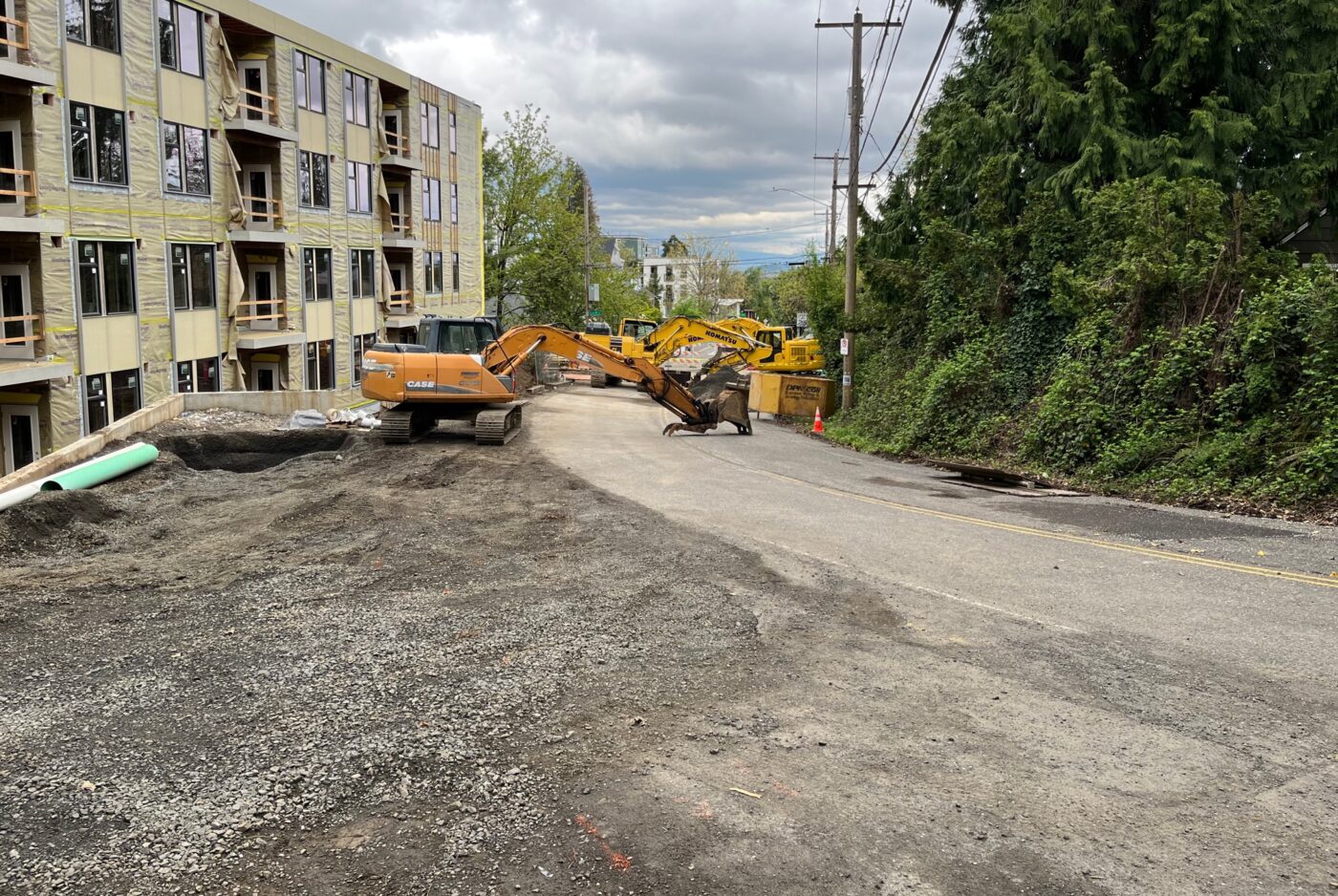
Nowhere to Walk on SW Gibbs
Previous stories in this series:
Last week I received an email from longtime southwest Portland trail activist Don Baack, who has been concerned that a protected pedestrian walkway wasn’t required along the frontage of a new apartment building under construction on Southwest Gibbs St.
Baack had contacted the office of Commissioner Mingus Mapps to learn more about the reasoning behind the Portland Bureau of Transportation’s decision to have pedestrians walk in the road, between the fog line and a guardrail. (Mapps is the commissioner-in-charge of PBOT.) Don thought it would be safer for a person walking to be separated from the traffic by the guardrail, on a path off the roadway.
Don got a response from the Commissioner’s office, which impressed me. My most recent queries to the bureau’s press office have gone unanswered, and back in September when I did get a response it was very general and applicable to most of the southwest.
PBOT said they required a six-foot shoulder widening on SW Gibbs as part of this development; but added that, “Unfortunately, due to significant storm water, soil, and topographical challenges on the hill we couldn’t require a standard curb and sidewalk improvement.”
What Don learned from Mapps’s office was more specific. A staff member wrote:
I checked with the bureau and there is a trade-off between protection from traffic and protection from the slope on the side of the street that led to the planned placement of the rail.
—Commissioner Mapps’s office
That’s a good, solid answer. But Don and I have walked the shoulder together, and we both know the area well. There is not a steep slope to the side of the street in front of this property.
That led me to pass on a couple of photos to Mapps’s office and ask for clarification about the “trade-off.” I received a reply that made me feel like I might be getting somewhere:
We have raised your concern with the bureau and they are looking into it to see what options we may have.
—Commissioner Mapps’s office
It seems positive to me that there might be other options.

What’s going on?
I don’t know exactly what’s going on, maybe I’ll learn more next week from the Commissioner’s office. If you’re feeling generous you can label the remainder of this post “analysis,” otherwise consider it speculation.
The six-foot (or less) shoulder widening seems to have become the default frontage requirement in southwest Portland, and it’s been that way for a number of years. There are reasons for that, for example the stormwater infrastructure might not exist, which limits the amount of impervious surface allowed, including cement sidewalks. The Bureau of Environmental Services (BES) was being straightforward on the frontage improvement/stormwater issue when it wrote in its West Portland Town Center memorandum that:
Neither PBOT or BES have discretionary funds to spend on infrastructure around future development projects, particularly on local streets, even if the developer is paying to improve all or portions of the ROW in front of their development. In addition, incremental improvements funded by developers may be possible for street improvements, but incremental stormwater improvements may not be possible in SW Portland because of the existing lack of infrastructure and downstream capacity limitations.
In other words, even if a developer wanted to build the usual required frontage improvement such as a sidewalk, the city might not allow it because the stormwater infrastructure isn’t present to handle the run-off. And the city does not have the money to put in new infrastructure for future developments. That means no sidewalks, and a code variance granted that puts pedestrians in the roadway in essentially a bike lane.
From what I can tell, however, that is not the situation on Gibbs. There is a combined sewer/drainage pipe under the road and the permitting documents do not mention lack of capacity as a reason for not allowing a sidewalk. It appears that a sidewalk was never considered.
But one can imagine how a rubric might have emerged that points to shoulder-widening as the default southwest solution, a rubric that misses the places where sidewalks are in fact possible, or that doesn’t encourage creative solutions to pedestrian safety.
As far as the non-existent slope goes . . . before the new building went up, there was indeed a steep bank in that location, which you might be able to see on the left side of the above photo, behind the chain link fence.
All of that area has since been backfilled against a retaining wall that sits on the property line, about three feet from the building. Maybe Development Review missed that?
The big picture: the Governor’s push to make building easier
Apparently, the city is not willing or able to invest in stormwater infrastructure for southwest Portland. Nonetheless, building continues, often without sidewalks. For example, what will happen with the Alpenrose site? I don’t know how that project is moving along, or if the city will require the developer to build sidewalks and bike lanes on SW Shattuck. It needs them.
The backdrop to southwest Portland’s active transportation woes is Governor Kotek’s controversial HB 3414 which is proceeding through the Oregon legislature. It is part of her push to rapidly increase Oregon’s housing supply in response to the houselessness crisis. The bill would limit the ability of cities to deny developer-requested variances (exceptions) to local building code requirements, like frontage improvements and bike storage. My observation in Portland is that PBOT’s Development Review office has always been generous in granting variances to frontage and transportation requirements. In fact, the city watered down its code governing transportation improvements in 2018 to make it easier for developers to comply with it.
The first question of Commissioner Rubio’s permitting process survey last winter fits in with the governor’s pro-developer response to the housing crisis: “What are the top five requirements the City of Portland should consider suspending or modifying to support increased housing productions?”
So what can and will be required of developers is in flux. Meanwhile, an entire area of town is densifying with little in the way of safe walking and biking facilities. And that is counter to numerous Portland policies. Most recently the three-year PedPDX status report reiterated its Mission Statement:
To an informed Portland resident, the contradictions between the city’s aspirational policy and the reality of what gets built is frustrating. And the possibility of hard-fought building requirements being sidestepped is alarming.


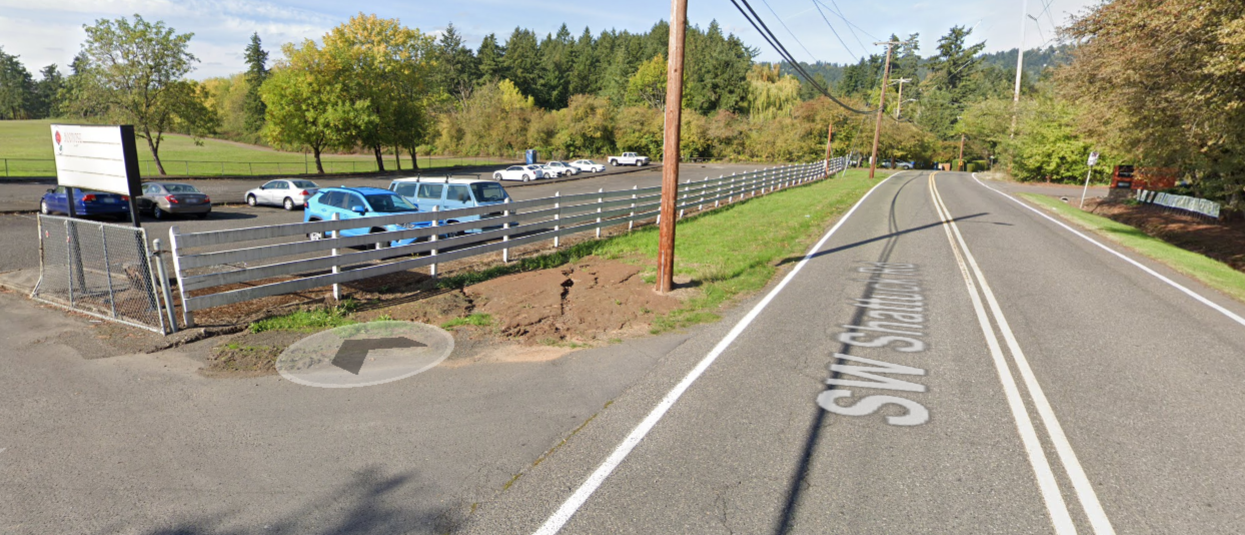


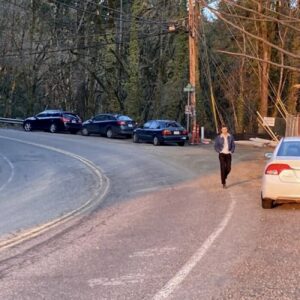
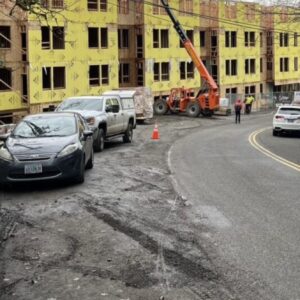

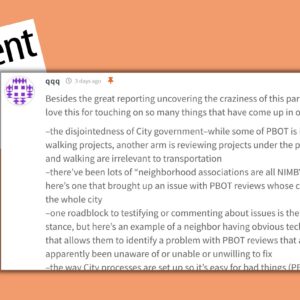
Thanks for reading.
BikePortland has served this community with independent community journalism since 2005. We rely on subscriptions from readers like you to survive. Your financial support is vital in keeping this valuable resource alive and well.
Please subscribe today to strengthen and expand our work.
At some point, we have to choose between building enough housing in our region to keep housing affordable and fight homelessness, and putting so many requirements on developers that they either build fewer units, or abandon their plans to build at all.
Just in the last few weeks I’ve read multiple articles in local newspapers where developers cited PBOT’s frontage requirements specifically as the reason they have abandoned their plans to develop apartment buildings, including the old Mary’s Club building on SW Ankeny St. I’m guessing that PBOT was applying the typical standard for street width and full sidewalk to what we all know is a tiny alley-like street and should really stay that way. And that property is really shallow, so there wouldn’t even be any building left!
I understand this desire for developers to fix all the infrastructure in front of their buildings, but at some point this needs to become a public cost, or at least have a public subsidy, because pushing all the costs on the private sector, like it or not, has a major impact on housing supply.
Atreus, thank you for the knowledgeable response. I have a quibble with something you say in your second paragraph, though.
Development Review always starts out requiring the full, standard frontage improvements (sidewalks, bike lanes, curb zone…) It’s pro forma and probably required legally.
But they only very rarely enforce that requirement. What happens instead is that at the Early Assistance meeting, Dev Rev advises the developer to request a Public Works Alternative Review. In response to that, the PWAR committee releases a Decision with lessened frontage requirements. That is what the standard is in practice.
I’ve only seen one location in southwest where the full suite of frontage requirements was met—the recent Capitol Hwy project.
Surely there is a solution between expecting pedestrians to walk in the street with cars, and the full Cap Hwy treatment.
And to add to your points, since we rely on the private market to provide the majority of our new development, we have to compete nationally and globally for much of the private equity that gets loaned into to Portland projects. As financing gets more expensive and the overall market becomes less predictable, fewer projects will generate sufficient returns to justify the risk that developers and investers take on. A public bank might be one way Portland could decrease financing costs to help projects pencil out while using profits to subsidize loans to projects that add to our affordable housing supply
If North Dakota can have a public bank, why can’t we?
https://en.wikipedia.org/wiki/Bank_of_North_Dakota
North Dakota also has a state-owned (and profitable!) grain elevator and flour mill, while both Montana and North Carolina have state-owned railroad companies. Since all three states are very conservative, none of these state-owned enterprises are at all “socialist.” Oh no…
Willamette Riverkeeper is deeply concerned about the negative environmental impacts of the bill HB 3414 that Kotek is pushing.
Here is what they say:
http://willamette-riverkeeper.org/
Wow! Yeah I was drawn to the Democratic Party because of its commitment to the environment but it seems at least in Oregon and Portland the far left progressive wing of the party has abandoned the environment as a priority. I see very little attention given to environmental issues (except for lip
service) by the city of Portland, Multnomah County and the Multnomah Democrats. Garbage everywhere, graffiti marring nearly every vertical surface, unsanctioned camping (not only allowed but enabled) and no concern over the resultant pollution from that.
Care for our waters and open spaces seem to have been supplanted by an “anything goes” approach to homelessness and the simplistic blaming of housing costs for all evils here in PDX.
Not sure what a disillusioned nature loving Democrat is to do.
Unlike some, I am OK with not having sidewalks where it’s a challenge – I am NOT okay with ‘you’ll walk in the road we’re pumping more cars onto and LIKE it” from PBOT. A ‘tradeoff’ between walking on an unprotected shoulder and a protected trail with some terrain is a tradeoff for their convenience, not safety. Sure I could faw down and go boom; I could also be killed by an inattentive driver. Did they ask any pedestrians about that tradeoff? NO – Alternative Reviews are opaque, and allow NO user input save the developer’s. Dev Rev’s JOB is to integrate new construction safely into the transit matrix, and they are apparently unwilling to do that job unless you are a driver.
It’s not just Gibbs – I have been told by neighbors the Alpenrose project will require NO offsite pedestrian or bike infrastructure, and there was likely to be none INSIDE the development.
Part of it is stormwater, to be sure, but a graveled protected trail doesn’t have the same requirements as an impermeable surface. Some of it might be ADA; some of it is cowardice at the City Attorney’s office (motto: ‘better to be sued for something you DIDN’T do than something you did’). But the main issue is hostility to pedestrian safety in SW at some level in DR, and the decision that working to come up with a solution takes too much time, and getting the plans approved and out the door is more important. Let the Ped and Greenway people clean up the mess later! Too bad we don’t give them any money for that…
This attitude predates Kotek’s bill, which hasn’t passed yet AFAIK. And it won’t affect SW that much anyways; one figure I saw said SW realistically only had some 4500 un- or underdeveloped sites anyways (the light rail bond would have allowed 20K more by paying for infrastructure required to support it in places).
Activists were hoping Mapps – an avid cyclist – would straighten things out but he seems to have drunk quite a few pitchers of the Koolade DR is selling, and is on board with the idea that pedestrian safety is too hard and too expensive to bother with in SW. So someone’s gonna have to work with that attorney mindset and sue them over something they won’t do. I only hope it doesnt require a fatality first.
Mapps has only been in charge of PBOT a few months. It’s gonna take awhile to correct the course of the PBOT ship after being piloted by ideologues like Eudaly and Hardesty.
I have heard rumors that some of those prmoting the auto uber alles line have been promoted under Mapps, so I doubt he will change things no longer how long he is in charge if true. And Hardesty and Eudaly were FOR pedestrian and bike safety. Most of the time…
Hardesty for bike safety? Is that why she objected to keeping our MUP’s clear of campers and said PBL’s on Hawthorne were not compatible with racial equity (I.e. racist)?
Someone confined to a wheelchair might disagree. If you would argue that in some places it is just too difficult to safely accommodate them, then you have to accept the argument that on some streets it is just too difficult to safely accommodate cyclists.
The whole approach of granting variances on request is total BS. If we don’t want sidewalks everywhere, let’s just change the rules to not require them. At least then everyone would know what is up.
I do agree – I suspect one reason PBOT is pretending there is no safe ped routes is because then they have to have ADA rules kick in (3′ gravel path is minimum). But just say it, instead of inventing 58 reasons why you can’t.
And PBOT also seems to think some streets are too dangerous for bikes, so not sure the point…
“– an avid cyclist –”
Mingus said in an interview that he rides a bike. Almost certainly he owns one. But avid?
To my mind an avid cyclist would find a way to bike to work sometimes. It’s practically the definition of the phrase, or at least half the definition, as in: ‘Pat Jones, an avid cyclist, rode 11,576 miles last year and commuted across the West Hills by bike twice a week in all weathers.’
I remember having to re-read the 1992 Americans with Disabilities Act (and its amendments) several times for content for various projects and policies. Sidewalks for example are not actually required anywhere, at least at the federal level, but rather a firm surface for wheelchairs, which is where the 6-foot rule starts. The required path is actually 5 feet (back in 1992 it was 3 feet and by 2006 was 4 feet) and can be gravel, asphalt, concrete, brick, and so on, but most jurisdictions want an extra 6 inch strip of right-of-way between the sidewalk/shoulder/path and private property, while the painted fog line between the sidewalk/shoulder/path and the roadway is also often 6 inches, so 6″+5’+6″=6 feet.
Thanks for updating me on that standard – I do still see some memos about trails referencing 3′ but maybe a ‘trail’ has a different standard in parks.
Are we really supposed to believe that a 4’ sidewalk instead of a 4’ gravel shoulder will increase storm water runoff to unmanageable levels? Put drains in the curb face to send runoff under the sidewalk and down the slope where it was going to go anyway.
Unless that is a (genuinely) affordable apartment development, why is the city bending over backwards to let the developer off the hook at the expense of pedestrian safety? It’s going to be real fun walking in the road on that curve in the dark or rain, if you’re 8, 80, or not fully-abled.
John, the developer was willing to build a cement sidewalk, at a public meeting he said he wanted to, but that PBOT “pushed back.”
The Feds say runoff needs to be treated if more than 500 sq ft of impervious cover is created, which means putting it in retention pond or sewer. Here, BES said there is PLENTY of room in the planned retention facility, so the runoff could then be released to drainages. PBOT said no anyways.
This whole thing stinks. If the local slopes and soils can support a street, which is a considerable piece of impermeable infrastructure, and if the city is allowing construction of multi-unit housing, which is a fancier kind of infrastructure that almost certainly an impermeable roof, there is a way to build a sidewalk. I don’t have standing to sue but hey, I can vote. Mingus Mapps will be in the election for the 12 member council. He’s laying low on this issue. I am not impressed.